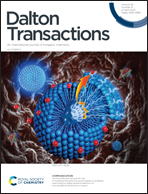C–H⋯Au interactions and optical properties of [(P,P)4Au6]2+ molecular gold nanoclusters†
Abstract
Two hexagold diphosphine-stabilized [(P,P)4Au6]2+ molecular nanoclusters with the same [core + exo] arrangement differing in the linker (phenylene or trimethylene) connecting the two P-donor sites have been subjected to theoretical studies with the aim of shedding light on two main questions. On one hand, from a previous study [J. Vícha, C. Foroutan-Nejadand M. Straka,Nat. Commun., 2019, 10, 1643], it is still unclear whether short C–H2⋯Au contacts revealed in the corresponding crystal structures are just forced by bulky P(Ph)2 groups and, on the other hand, to what extent the linker affects the visible band position [M. A. Bakar, M. Sugiuchi, M. Iwasaki, Y. Shichibuand K. Konishi, Nat. Commun., 2017, 8, 576]. Here, it is demonstrated that even in simpler model systems in which bulky groups were replaced by PH2 groups, C–H2⋯Au hydrogen bonding interactions are retained and show comparable values, as measured by NBO and QTAIM analyses, to those of 1 and 2. These analyses further confirmed a stronger HB in 1 than in 2. Also, the comparison of model systems without and with a linker connecting the phosphine groups showed a bathochromic shift of 47 and 60 nm, revealing the key role of the linker. The Δρ(r)EE–GS plots of 1 and 2 revealed electron density depletion in the inter-nuclear C–H2 region upon electronic transition unveiling its contribution to their optical properties.
![Graphical abstract: C–H⋯Au interactions and optical properties of [(P,P)4Au6]2+ molecular gold nanoclusters](/en/Image/Get?imageInfo.ImageType=GA&imageInfo.ImageIdentifier.ManuscriptID=D0DT00464B&imageInfo.ImageIdentifier.Year=2020)


 Please wait while we load your content...
Please wait while we load your content...